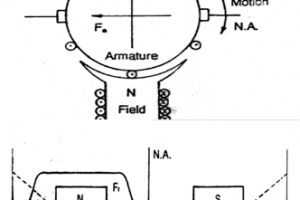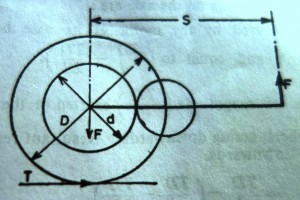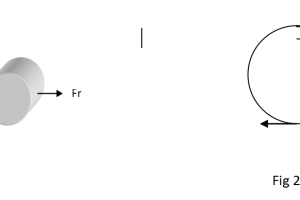Electric Locomotive
DC Series Motor as Traction Motor

Last updated on April 5th, 2015 at 06:14 am There are two basic principles which governs the working of DC machine A current carrying conductor placed in a magnetic field experiences a force demonstrated by Lorentz Law. Direction of the force is given by Fleming’s LH rule. A voltage is induced in the conductor […]
Braking Effort

Last updated on April 5th, 2015 at 06:14 am Braking effort is the effort required to stop the train within safe braking distance. It has safety consequences. Braking effort is required to counter the kinetic energy of train running at a speed V and can be expressed as . where D is braking […]
Weight Transfer

Last updated on April 5th, 2015 at 06:14 am When a locomotive is standing still on straight track, its weight is uniformly distributed on all axles but during traction, reactive forces and turning moments re-distributes the loading on each axle. System for transmission of Tractive effort from wheel to axle-bogie-body-draw bar pull results into non-uniform […]
Wheel Slipping and Sliding
Last updated on March 23rd, 2014 at 05:02 pm Wheel slipping occurs when tractive effort exceeds adhesive weight whereas sliding occurs when braking effort exceeds adhesive weight. In both the situations, it is the adhesive weight playing the most important role. Adhesive weight is defined as the force that can be exerted by a […]
Tractive Effort

Last updated on July 29th, 2019 at 04:51 am Tractive effort is the force required to haul a load. Tractive effort, when multiplied with speed at which the train is required to run, gives the HorsePower. Importance of Tractive effort lies with its capability to start a train on the gradient and run it up […]
Train, grade, curve and Acceleration Resistance
Last updated on February 6th, 2017 at 10:19 am Trains resistance is defined in terms of force required to encounter resistance arising due to vehicle, track, grade, curve, acceleration, wind at different time and place etc. Study of these resistances and its impact in train motion is important to develop strategies for reducing it. It […]
Adhesion

Last updated on April 5th, 2015 at 06:13 am Adhesion is one of the most important term used in Railways parlance signifying the ability of efficient heavy haul and safe braking. Adhesion limits the tractive and braking effort per traction and braking wheel respectively. On Indian Railways, adhesion limitation has caused more concern of wheel […]
Traction Mechanics

Last updated on November 21st, 2014 at 08:15 am Traction Mechanics is the study of train motion. The mechanics involves conversion of overhead electrical power/diesel/steam power in rail horse power to haul a train encountering acceleration, train, grade, curve resistance and similarly braking. Traction Mechanics involves concept of train resistance tractive effort braking effort adhesion […]